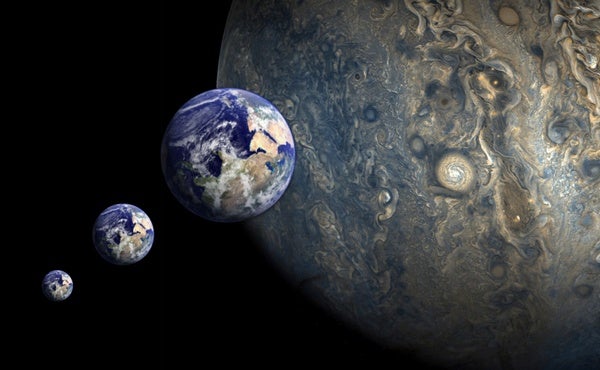
Humans love attaching labels to phenomena. For science, labels or categories can also be extremely useful. They become shorthand for the detailed properties of objects or mechanisms, or signposts to the origins and history of something.
In astronomy though, labels seem to run into all kinds of troubles. In the past couple of decades one of the most contentious (and rather gratuitously overwrought) debates has been on whether or not Pluto is a planet. I won’t go into the gory details here, but did discuss a little of this a while back. In fact, I made a modest proposal that we perhaps should just call everything a planet, with a suffix indicating the size of these condensations of matter, from sub-yocto-planets (interstellar dust grains) to hecto-planets (like Jupiter).
The drawback of that kind of approach is that the label wouldn’t tell us more about the specific environment or origins of objects. That’s really what we’d like our scientific names to help with. So, by ‘planet’ referring to certain objects, and terms like dwarf planet, or trans-Neptunian object referring to other seemingly similar objects we gain a little bit of insight into what differentiates these items in terms of location and perhaps origins.
Recently, after my colleagues Alex Teachey and David Kipping published their latest work on evidence for the existence of a moon around an exoplanet (in the system Kepler-1625.) things have gotten a little heated up again on the labeling front. Their candidate planet-moon system is challenging for our present understanding of how planets and natural satellites might form. This system may contain a world some three times Jupiter’s mass orbited by an object similar in size to Neptune. So is that an exomoon? A Neptmoon? Or a binary planet system?
For a binary (or double) planet we do have one physically motivated criterion – the center of mass of the two objects must lie outside the surface of either. Of course, no one even really agrees on this, but I think it’s a pretty reasonable marker. That would make Pluto and Charon a binary or double system for example, while the Earth and Moon are not a binary. The hitch is that eventually the Moon’s orbital evolution will move it far enough from the Earth that the center of mass will end up outside both objects. The universe clearly doesn’t care about our nomenclature desires.
Following up an interesting question about the putative Kepler-1625b exomoon, Juna Kollmeier and Sean Raymond have gone further and written a short research paper on the topic of what properties allow for a moon to have its own natural satellites. A little while before, the astrophysicist Duncan Forgan had also produced a study on the possibility of Kepler-1625b's putative moon itself having an Earthlike satellite object.
To evaluate the chances of a moon of a moon you need to extend the calculations that allow us to find stable orbits for spacecraft around our Moon, or indeed any natural satellite in the solar system. The complication mainly comes from the nature of gravitational tides, which can, over time, destabilize orbits. The bottom line is that yes, in principle there will be situations where the moon of a planet can itself have natural bodies going around it in long-lasting orbits. Forgan used the term "moon-moon", Kollmeier and Raymond used "submoon".
All of this caught the attention of the media and social media and next thing we’re seeing excited talk of “moonmoons” among other new potential labels. All lots of fun.
But it does raise the question of whether we really need agreed-upon labels for these things. And this is, once again, tricky. As we’ve seen with the case of Pluto, there’s clearly a limit to the purely scientific benefits of having a universal classification scheme.
For one thing, we now know that our solar system is not a particularly good representative of the greater population of planetary systems that number in their trillions across the observable universe. On the other hand, how are we meant to talk about objects in the universe? In English at least, we like relatively straightforward, succinct names for things. We don’t do nested, hierarchical names very well. Writing out ‘sub-moon of a Neptune-mass moon of a super-Jovian giant planet in an exoplanetary system’ would be a lot of annoying baggage to use every time.
I think the root of the problem is that what we really need are two slightly different things. On the one hand we want a nice colloquialism – something handy for general use, a label that at least lands us in the right general place for a discussion. On the other hand, we’d also like to have a systematic naming system that precisely identifies the nature and circumstances of ‘planet-like’ stuff in the cosmos.
I don’t know what the solution to the latter is. All of these planets, moons, dwarf planets, and so on are types of sub-stellar bodies (although sub-stellar is often used to indicate objects that are somewhere between planets and stars in mass, just to confuse things). Maybe we shouldn't talk about planets at all. Or perhaps we want some kind of astrophysical Boolean notation: NOT(planet OR moon)?
For the former naming issue, well perhaps we should just go crazy? ‘Moonmoon’ does get us in the right ballpark, so does ‘sub-moon’. And as for exomoons of different sizes, Terramoon or Neptmoon could work, although one might wonder if these are moons in our solar system, and what about moons of these moons? Terraneptmoon would be a mouthful, but it does express the extraordinary hierarchy that such an object would represent.
Thankfully there's been minimal discussion (to my knowledge) so far on sub-sub-moons...
Bagikan Berita Ini















0 Response to "Planets, Moons, Moonmoons: Why Is This so Hard?"
Post a Comment